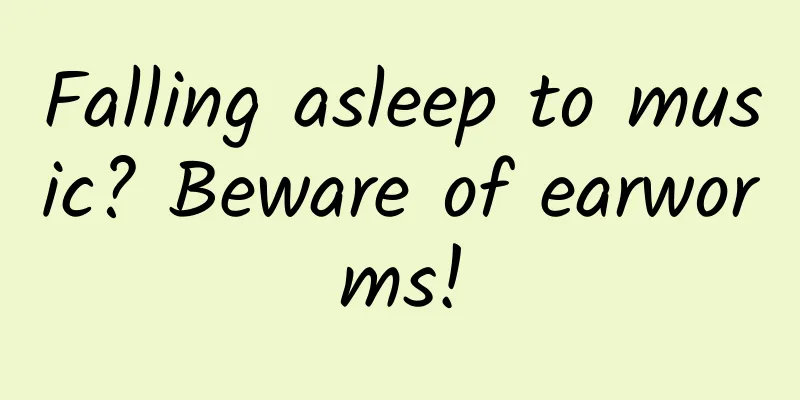Falling asleep to music? Beware of earworms!

|
Many people have the habit of listening to music before falling asleep, believing that this helps them sleep. But this method doesn't work at all for some people, and they may even become more energetic the more they listen. Michael Scullin, an associate professor of psychology and neuroscience at Baylor University in the United States, found that when he woke up in the middle of the night, a song would linger in his mind, which affected his sleep quality. So he began to study the relationship between listening to music and sleep. He focused on a mechanism that has rarely been explored: when a song or melody is played repeatedly, people tend to repeat the song (or melody) in their minds as if they were brainwashed, and they may even hum it unconsciously. This is called the "earworm effect." Earworms are involuntary musical images that usually occur while awake, but Scullin found they can also occur while trying to sleep. The findings are published in Psychological Science. "It's common for teens and young adults to listen to music before bed, but the more often you listen, the more likely you are to pick up an earworm that won't go away," Scullin said. "When that happens, your sleep may be affected." The study surveyed 209 participants about their sleep quality, music listening habits and how often they heard earworms, including how often they heard them when trying to fall asleep, when waking up in the middle of the night and when first waking up in the morning. In addition, the researchers brought 50 participants to Scullin's Sleep Neuroscience and Cognition Laboratory to try to study how "earworms" affect sleep quality. The researchers played three popular songs, and the participants were randomly assigned to listen to the original songs or the instrumental version without the lyrics. The results showed that participants with the "earworm effect" had more difficulty falling asleep, woke up more often during the night, and spent more time in the light sleep stage. Compared with people who rarely experience earworms, people who experience earworms once or more per week have six times worse sleep quality. Surprisingly, the study found that some instrumental music (without vocals) was more likely to cause earworms and disrupt sleep quality than lyrical songs, and was twice as likely to cause earworms as other music. In addition, the researchers conducted a quantitative analysis of EEG readings (recordings of the brain's electrical activity) from the 50 subjects to examine physiological markers of sleep-dependent memory consolidation. "Participants who experienced the 'earworm effect' showed slower vibrations during sleep, a sign of memory reactivation," Scullin said. Scullin said that almost everyone believes that listening to music can improve sleep, but studies have found that those who listen to more music have worse sleep quality. How to get rid of the "earworm effect"? Scullin suggested that you first try to listen to music moderately. If you are disturbed by the "earworm", you can take a break occasionally. "The timing of listening to music is also important, try to avoid listening to music right before going to bed." "If you listen to music in bed regularly, then this association could be created, and even if you're not listening to music, it could trigger the 'earworm effect' when you're trying to sleep," he said. Another way to get rid of earworms is to engage in cognitive activities. Focusing completely on a task, problem, or activity can help distract your brain from the earworm. Avoid engaging in demanding activities or doing things that could disrupt sleep, such as watching TV or playing video games, before bed, Scullin advises. Spending 5 minutes before bed writing down upcoming tasks can help "get out" of worrying about the future and help you fall asleep faster. Source: China Science Daily Author: Xin Yu Related paper information: https://doi.org/10.1177/0956797621989724 The pictures in this article with the "Science Popularization China" watermark are all from the copyright gallery. The pictures are not authorized for reprinting. |
<<: Do you really know our closest primate relatives?
>>: Looking back again, the two years stolen by the epidemic
Recommend
How do Taobao and Tmall sellers build private domain traffic?
Companies began to shift from acquiring new users...
After experiencing the growth of Bilibili from 1 to 10, I have 5 profound insights
You will find that the larger the community, the ...
Mac EFI exposed a major security vulnerability that spreads through Thunderbolt devices
Apple today released security patches for OS X Yo...
Android M full name Android Marshmallow
Last week, Google released a promotional video fo...
The 10 most disappointing founders of 2015
[[161252]] Editor's note: In this article, St...
How will Lenovo operate after Motorola returns to China?
Xiaomi held the title of "world's third&...
A 4-year-old girl in Shanghai got lost on the beach! There are many dangers near the water that you would never imagine...
These days, the safety of the missing 4-year-old ...
Summary of essential tools for new media operations and promotion! (superior)
If you want to do your work well, you must first ...
How to master bidding promotion?
The number of consultations has not decreased, bu...
50 essential proposal writing skills for planners in 2020
During my time as Party B, I wrote hundreds of pr...
Are there many heroes or two strong contenders? The war among two-dimensional video websites ignites
In the field of two-dimensional video, Station A ...
“Leaves no marks”, “Safe mole removal”, is the Internet celebrity potion really so magical?
Many people have some moles on their bodies or fa...
You may be eating these five types of foods that cause inflammation every day! Reminder →
Many diseases that plague the human body All have...









